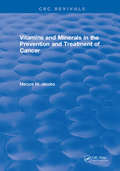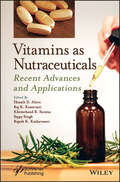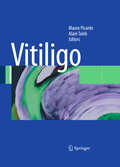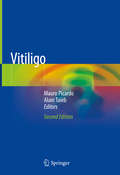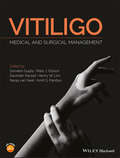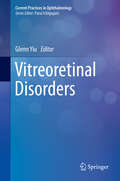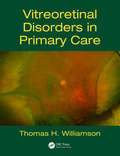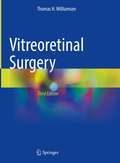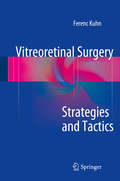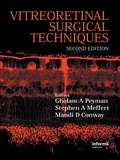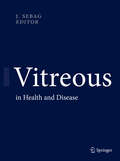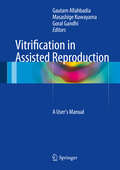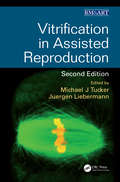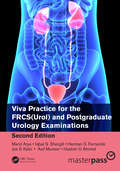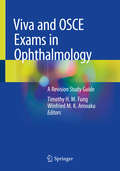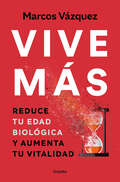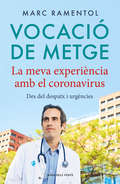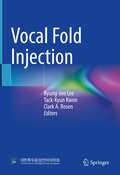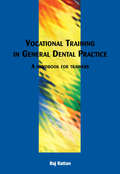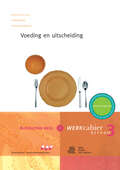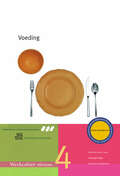- Table View
- List View
Vitamins and Minerals in the Prevention and Treatment of Cancer
by Maryce M. JacobsThis book provides researchers and practitioners with a unique collection of current research on the role of vitamins and micronutrients in cancer prevention and treatment. New theories are discussed, including a hypothesis that dietary factors may protect against genetically predisposed cancers. Mechanisms by which different vitamins and minerals appear to inhibit carcinogenesis or cell transformation are described, including vitamins A, C, E, and selenium protection against oxidative stress by induction of enzymes as catalase and dismutase or inteference with free radical mechanisms; organosulfur compound inhibition of P450 activation enzymes or enhancement of detoxification enzymes; metal ion effects in the modulation of gene expression by site-specific binding of Zn-finger loop domains; B-carotene metabolite up-regulation of gap junctional communication between cells; and vitamin D3 elimination of amplified oncogenes or drug resistant genes. The book also reviews literature implicating a possible relationship between potassium and the control of cancer. Other information presented includes a discussion of contemporary technologies and data associating lipotrope deficiencies with alterations in xenobiotic metabolism, nucleic acid methylation, purine and pyrimidine synthesis, signal transduction, and chromosome anomalies.
Vitamins as Nutraceuticals: Recent Advances and Applications
by Raj K. Keservani Rajesh K. Kesharwani Eknath D. Ahire Khemchand R. Surana Sippy SinghVitamins as Nutraceuticals The book examines the development of nutraceutical products featuring maximizing the vitamin benefits to human health and various health conditions. Since vitamins are widely predicted to be one of the most significant nutritional advancements over the next 25 years, the editors of this book have brought together renowned experts in the field to provide a single authoritative resource for the nutraceutical sector. It is being published at a time when there is a pressing need to address the rising number of cases of nutritional deficiency disorders and the high number of deaths caused by a lack of knowledge or a deviation from healthy eating habits. The book contains 12 chapters and begins by defining and classifying the field of vitamins, with a focus on legislative issues in both the United States and the European Union. In addition to discussing recent advances and applications, this book also includes scientific information on the importance of vitamins as nutraceuticals to human health, as well as the potential mechanisms of nutraceuticals in illness prevention, management, and control. The focus is on vitamins as nutraceuticals for health conditions such as human nutrition, pregnancy, oral health, anemia, and blindness. The book also explores the structure and function of various vitamins and covers the impact of various vitamins on immunity and the nutraceutical properties of seaweed vitamins and marine-derived sources of nutritional vitamins. The beneficial effects of water-soluble vitamins in nutrition, health promotion, and nutraceutical potential of fat-soluble vitamins, are also discussed. Audience The book will be read by a range of researchers and industry scientists such as vitamin formulators, food scientists and food manufacturers, as well as those in the pharmaceutical industry, nanotech industry, novel drug delivery research laboratories, and the health sector.
Vitellogenin in Fishes- Diversification, Biological Properties, and Future Perspectives
by Vaseeharan Baskaralingam Rapeepun VanichviriyakitThis book provides basic and advanced information on vitellogenin in fish. The proposed book discusses the history of vitellogenin, previtellogenesis, their diversification and classification in fishes, and tools for their identification and characterization. Further, their functional aspects in oogenesis and its regulatory mechanism, role as the immunocompetent molecule, and reproductive strategies are discussed. The book further examines vitellogenin as a hormone and biomarker, its related egg yolk proteins, and its mechanism on molecular cloning and induction. In addition, the book discusses its role in the disruption of the endocrine system in fish, its biological activities, its multivalent mechanism in marine and freshwater fishes, and its impact on the growth of ornamental fishes. Moreover, this book elaborates on the multiple vitellogenin genes, each with unique promoter regions and varying sensitivity to induction by estradiol, and multiple Vtg proteins themselves, with variable degrees of post-translational modification. As such, this book is helpful for researchers and students interested in the reproduction of fishes and reproductive biology.
Vitiligo
by Alain Taïeb Mauro PicardoVitiligo is one of the most common cutaneous disorders. Great numbers of affected patients suffer from the high stigmatizing impact of this disease. Up to now, clinical guidelines for the treatment of vitiligo were non-existent. In order to fill this void, this textbook defines and gives a complete overview of the disease, both regarding the classification of differential diagnosis as well as the treatment. Written by the most authoritative experts in the field, all therapy recommendations are based on new evidence-based guidelines. It includes case studies with illustrations before and after the treatment in order to demonstrate the treatment success. This textbook will be a valuable resource for all physicians who are seeing patients with this disease.
Vitiligo
by Alain Taïeb Mauro PicardoSince the first edition of this book was published, new knowledge has been gained on Vitiligo. This widely revised and updated second edition, written by worldwide experts in the field, fully reflects this progress. The apparently, simple and poorly symptomatic presentation of the disease has been a strong disadvantage to its study, as compared to other common chronic skin disorders such as psoriasis and atopic dermatitis. A good skin-based angle of attack is also lacking because generalized Vitiligo is clearly epitomizing the view of skin diseases as simple targets of a systemic unknown dysregulation (diathesis). This view has mostly restricted Vitiligo to the manifestation of an auto-immune diathesis and skin events, which are easily detected using skin biospies in most other situations, have not been precisely recorded, with the argument that a clinical diagnosis was sufficient for the management of the patient with Vitiligo. This richly illustrated second edition reflects the constant international effort to share the information gathered about this disorder at the clinical, pathophysiological and therapeutic levels. Its aim still being to bridge current knowledge at the clinical and investigative level, to point to the many unsolved issues, and to delineate future priorities for research.
Vitiligo: Medical and Surgical Managmement
by Henry W. Lim Amit G. Pandya Somesh Gupta Dr Mats J. Olsson Dr Davinder Parsad Nanja Van GeelPractical guidance based on expert experience and evidence for developing management strategies for vitiligo This complete guide to vitiligo provides a full appraisal of strategy for the treatment of this autoimmune disease that affects 1-2% of the world’s population. It addresses all aspects of vitiligo, covering the science, medical and surgical therapies, and the psychological evaluations and approaches based on the proper understanding of the causes and classification of a particular case. Management of vitiligo is challenging and requires a multipronged approach. Vitiligo: Medical and Surgical Management is a comprehensive, timely, state-of-the-art resource that will help those involved with affected patients better understand and treat this disease, which takes its toll on the mental wellness of those afflicted by it. It takes an evidenced-based approach to the disease’s treatment; provides an overview of the surgical management; covers tissue and cellular grafting; and more. Thoroughly guides those involved in the clinical aspects of vitiligo Aids diagnosis and classification of severity Balances evidence and experience Compiled by world-leading expert editors Comprehensive in nature, Vitiligo: Medical and Surgical Management contains a strong practical element, and is a welcome go-to source for practicing dermatologists and those training to become a dermatologist.
Vitreoretinal Disorders (Current Practices in Ophthalmology)
by Glenn YiuThis book discusses the newest trends, concepts, and advancements in the management of vitreo-retinal conditions. The field of retina is rapidly changing, with new advances ranging from stem cell therapy, gene therapy and editing, new drug targets, novel delivery systems, and innovative technologies in advanced ocular imaging and surgical techniques. The goal is to provide a way to update practitioners and trainees on how the field of retina is changing. Areas of focus include new technologies, particularly in ocular imaging and vitreo-retinal surgery, major new clinical trials, particularly those that are shifting practice patterns or addressing novel therapies, and novel research that is altering the classification and diagnosis of retinal conditions, as well as management strategies and prognostic predictors for vitreo-retinal diseases. This volume is essential reading for generalist and specialist ophthalmologists and useful for residents and fellows training in various subspecialties.
Vitreoretinal Disorders in Primary Care
by Thomas H. WilliamsonEmergency ophthalmology is an area full of pitfalls for the unwary primary care practitioner. Vitreoretinal disorders make up the majority of emergency sight-threatening conditions, and a wide and increasingly varied range of conditions of the eye present in primary care settings. Correct diagnosis at initial presentation, and appropriate and speedy referral, are extremely important. This book is therefore an essential reference for the primary care physician, who is often the first to see these patients and is in a position of responsibility for decision-making.
Vitreoretinal Surgery
by Thomas H. WilliamsonThis is the second edition of a highly successful textbook that in many areas has become the preferred manual of vitreoretinal surgery. It provides a complete guide to all common vitreoretinal surgical procedures and also covers diagnosis and other aspects of management. The book is designed to allow a trainee or professional vitreoretinal surgeon to determine the best methodology in individual cases. In order to acquaint the reader with different opinions, "surgical pearls" have been contributed by other international experts in the field. These have proved popular in the past as an illustration of alternative methods, without detracting from the overall method described by the main author. Vitreoretinal Surgery will continue to prove particularly popular amongst trainees, but will also be of value to practicing professionals who need help in the management of difficult and rare cases. The text is backed up by the provision of videos of some aspects of the surgery.
Vitreoretinal Surgery
by Thomas H. WilliamsonThis is the third edition of a highly successful textbook that in many areas has become the preferred book of vitreoretinal surgery. It provides a complete guide to all common vitreoretinal surgical procedures and also covers diagnosis and other aspects of management. The book is designed to allow a trainee or professional vitreoretinal surgeon to determine the best methodology in individual cases. In order to acquaint the reader with different opinions, “surgical pearls” have been contributed by other international experts in vitreoretinal surgery. These have been welcomed in the past as an illustration of alternative methods, without detracting from the overall method described by the main author.Vitreoretinal Surgery, 3rd Edition will continue to prove particularly popular amongst trainees, but will also be of value to practicing professionals who need help in the management of difficult and rare cases.
Vitreoretinal Surgery: Strategies and Tactics
by Ferenc KuhnThis book is exceptional in explaining not only when and how but also why vitrectomy is performed - an additional focus that will help trainee surgeons to develop their own critical thinking. Uniquely, the book's first part describes "the life of the vitreoretinal surgeon" to help residents decide whether the field is indeed suitable for them, and if yes, how they can chart their own course in the absence of a formal fellowship program. The second and third parts discuss the fundamentals in VR surgery, such as the general philosophy underlying vitrectomy, equipment, examination, timing, anesthesia, the surgeon's posture, and the organization of the operating room. The final two parts are dedicated to surgical strategy and tissue tactics, reviewing the principles of surgical maneuvers and the practical sides of diagnosis-specific issues. An appendix is also included, which offers additional guideposts for the aspiring trainee surgeon, including a description of how an ideal mentor should act in surgery. The book is written in an easy-to-follow format with bullet points and text boxes, and has well over 250 color images and line drawings as well as over 60 tables.
Vitreoretinal Surgical Techniques, Second Edition
by Gholam A. PeymanVitreoretinal Surgical Techniques, Second Edition provides basic and comprehensive coverage of all aspects of surgery for the vitreous and retina. It provides an array of techniques useful not only to ophthalmologist in training but also to the practicing vitreoretinal specialist. This superb and invaluable text is both authoritative and practical as experienced practitioners explain their surgical approach in step-by-step illustrations of operative techniques.This new edition, contains 87 chapters with almost 900 illustrations, most of which are in color. Vitreoretinal Surgical Techniques, Second Edition will be essential for vitreoretinal specialists, comprehensive ophthalmologists, residents, and fellows, as well as in training programs and libraries.
Vitreous
by J. SebagThe vitreous body long has been the most mysterious of all ocular structures, owing perhaps to its seeming simplicity. There have been few concerted, sustained efforts to unravel the mysteries of how vitreous is composed and what role it plays in normal physiology as well as pathology. Over the years, however, many studies have produced important findings concerning vitreous biochemistry, structure, physiology, and pathobiology. Published on the 25th anniversary of Sebag's first book on Vitreous, this second installment is nearly five times longer than its predecessor, reflecting how much has been learned in the past quarter century. This well-constructed compendium not only addresses the most current scientific knowledge, but also reviews clinical perspectives in a manner that lends richness to the scope of the book. Written by 90 authors, this book has 56 chapters organized into 7 sections: Biochemistry; Anatomy, Development, and Aging; Pathology/Pathobiology; Physiology and Phamacotherapy; Posterior Vitreo-Retinal Surgery; Peripheral Vitreo-Retinal Surgery; and Pharmacologic Vitreolysis. With a foreword by Coleman & Lincoff and an introduction by Wallace Foulds, Sebag's latest tome on vitreous is destined to be the authoritative text for years to come.
Vitreous Microsurgery
by Steve Charles Stephen Huddleston Byron WoodWritten by a world-renowned pioneer in vitreoretinal surgery, Vitreous Microsurgery, 6th Edition, is an up-to-date, comprehensive how-to guide to all vitreoretinal procedures. Dr. Steve Charles, along with Drs. Stephen Huddleston and Jonathan Brugger, takes readers step by step through the decision-making process for evaluating the best course of treatment, and describes in detail clinically proven methods of managing the anterior and posterior segment vitreous surgery patient in a systematic manner. Numerous algorithms assist with intraoperative decision making, relying on knowledge of physical principles and performed in the order of ascending risk.
Vitrification in Assisted Reproduction
by Gautam Allahbadia Masashige Kuwayama Goral GandhiAdvances in technology now offer promising solutions to deal with the chronological aging of the cell, tissue or organ to synchronize its existence and its use. This book covers the developments in and benefits of the latest vitrification technology and its extensive applications in reproductive medicine. Protocols of gametes (oocyte and sperm), embryos, blastocysts and ovarian tissue cryopreservation have been reviewed by leaders in the field. In order to address the escalation in cross-border reproductive tourism entailing the transfer of reproductive cells and tissues rather than the patient, the challenges, caution and emerging possibilities of nitrogen vapor shipment of vitrified cells have been discussed. Current perspectives on oocyte banking present the reader with options and solutions to effectively utilize these gametes despite the physiological deterrents. The versatile applications and potential of vitrification of human embryonic stem cells, discussed in the concluding chapter, is an exciting reality offered by vitrification to help overcome numerous stumbling blocks in the management of various disorders.
Vitrification in Assisted Reproduction (Reproductive Medicine and Assisted Reproductive Techniques Series)
by Juergen Liebermann Michael J. TuckerVitrification in Assisted Reproduction presents standard and new cryopreservation techniques in detail, outlining those that have resulted in success, and providing recommended means for overcoming typically encountered problems.This new edition provides a much broader range of clinical application and data to demonstrate its contribution to the us
Viva Practice for the FRCS (Masterpass Ser.)
by Iqbal Shergill Manit Arya Asif Muneer Herman Fernando Jas Kalsi Hashim AhmedThis is the first revision book to be published specifically for candidates sitting the FRCS(Urol) examination, which tests the required standard of a recognised Urology specialist. It provides a selection of common clinical scenarios together with a guide to answering the FRCS(Urol) questions. Each chapter is written by Consultant Urological Surge
Viva and OSCE Exams in Ophthalmology: A Revision Study Guide
by Winfried M. K. Amoaku Timothy H. M. FungThis book provides a core revision resource for candidates sitting part 2 of the FRCOphth and other UK and international qualifying exams such as the FRCS, MRCS, FAMS and FRANZCO. Clear, didactic chapters logically outline the requirements for Structured Vivas and Objective Structured Clinical Examination with ‘Do’s and Don’ts’ for each section. Viva and OSCE Exams in Ophthalmology: A Revision Study Guide fills the need for a study companion that contains all the required resources in a single usable guide for candidates sitting fellowship exams to become a registered ophthalmologist or surgeon. Ophthalmic specialist trainees, specialty doctors, staff grades, and associate specialists who wish to become a fellow will find this book to be an essential guide to revising for oral and clinical based exams in ophthalmology.
Viva and OSCE Exams in Ophthalmology: A Revision Study Guide
by Winfried M. K. Amoaku Timothy H. M. FungThis book provides a core revision resource for candidates sitting part 2 of the FRCOphth oral exam and other international qualifying exams. Clear, didactic chapters logically outline the requirements for Structured Vivas and Objective Structured Clinical Examination with &‘Do&’s and Don&’ts&’ for each section. Viva and OSCE Exams in Ophthalmology: A Revision Study Guide, 2nd Edition has been fully revised to cover new clinical trials, guidelines and technologies that have emerged since the first edition and now play a vital role in the way we practice clinically. This book is an essential resource for any candidate who will be sitting the Part 2 FRCOphth oral exam, including ophthalmic specialist trainees, specialty doctors, staff grades, and associate specialists. International ophthalmologists who want to increase their general ophthalmic knowledge or those who wish to become a fellow by examination will also find this book to be of significant benefit.
Vive más: Reduce tu edad biológica y aumenta tu vitalidad
by Marcos VázquezHerramientas prácticas para reducir la edad biológica y rejuvenecer. De la mano de Marcos Vázquez, el divulgador de salud más reconocido en habla hispana, vamos a adentrarnos en el proceso de envejecimiento del cuerpo humano para descubrir qué es y por qué y cómo envejecemos. Marcos Vázquez nos adentra en el proceso de envejecimiento del cuerpo humano para descubrirnos qué es y por qué y cómo envejecemos.Nuestra edad cronológica avanza siempre a la misma velocidad y en la misma dirección, pero nuestra edad biológica es mucho más flexible y moldeable; los últimos avances científicos indican que puede incluso retroceder: REJUVENECER ES POSIBLE. Vive más es la guía esencial para entender la ciencia de la longevidad y, sobre todo, para aplicarla de manera personalizada, proporcionando herramientas prácticas para mantener la salud y la vitalidad con el fin de ralentizar el envejecimiento y mejorar la calidad de vida y la apariencia. En ella aprenderás que el ejercicio es el elixir de la juventud, qué alimentos ralentizan el envejecimiento y qué efecto tienen estrategias como el ayuno intermitente. Nos enseña cómo potenciar el sistema inmunitario y optimizar las hormonas sexuales o cuáles son los mejores suplementos para alargar la juventud.En resumen, aprenderás las claves para morir joven, con muchos años. Pero Vive más va más allá. La última sección resume las tecnologías emergentes que nos permitirán, en pocas décadas, alargar de manera exponencial nuestra longevidad. El futuro es increíble, y está más cerca de lo que piensas.
Vocació de metge: L'emergència sanitària més enllà de la pandèmia
by Marc RamentolUn llibre que posa en valor la vocació de metge i el paper que han tingut els professionals sanitaris en aquesta crisi, a través del testimoni únic del director general del Departament de Salut. Marc Ramentol, com a gestor públic, analitza com va arribar el coronavirus a Catalunya i què hem après d'aquesta crisi sanitària, i, com a metge, explica la seva experiència quan decideix tornar, en ple pic de la pandèmia, al Servei d'Urgències de l'Hospital Universitari Vall d'Hebron. El doctor Marc Ramentol, director general del Departament de Salut, decideix, en plena crisi pel coronavirus, reincorporar-se al Servei d'Urgències de l'Hospital Universitari Vall d'Hebron, on falten mans per atendre l'allau de malalts per COVID-19 que hi arriben. Estàvem preparats per fer front a una pandèmia d'aquesta magnitud? Com ha estat la desescalada? I els rebrots que han de venir? El doctor Ramentol ens ofereix el seu testimoni únic a primera línia de la crisi sanitària com a gestor públic i metge. Sens dubte, els professionals sanitaris i els gestors públics de la pandèmia han estat els protagonistes d'aquesta crisi, que ha demostrat, més que mai, la vocació dels professionals sanitaris del nostre país.
Vocal Fold Injection
by Clark A. Rosen Byung-Joo Lee Tack-Kyun KwonThis book provides step-by-step illustrated descriptions of diverse vocal fold injection techniques, including some not previously described. The aim is to provide laryngologists in general, and especially those who are less experienced, with the detailed understanding and guidance needed in order to achieve optimal outcomes. Highly experienced experts describe approaches via the transoral, transnasal, and transcutaneous routes and offer guidance on indications, injection materials, pre- and postoperative care, and the management of complications. Special considerations that must be borne in mind when employing different vocal fold injection techniques, in different settings, are also carefully explained. In offering comprehensive, up-to-date information on this minimally invasive and cost-effective procedure, Vocal Fold Injection will be an essential aid for practitioners.
Vocational Training in General Dental Practice: The Handbook for Trainers
by Raj Rattan Ian WaiteVocational training is the preferred method for developing practical and other workplace dental skills. It is mandatory for all UK dental graduates under the guidance of the Committee on Vocational Training (CVT). This book is for all dentists who have an interest in vocational training, and is particularly useful for trainers, VDPs and VT advisers/regional advisors. This is a unique and comprehensive guide to training in practice. All aspects of training and teaching methods are included and practical advice given on topics such as communication and presentation skills, finance, barriers to training and assessment. The book also covers the latest developments in clinical governance and legal matters. Clear, straightforward and free of jargon, it will enable dental practitioners to become competent educators with ease.
Voeding en uitscheiding.: Werkcahier Kwalificatieniveau 3 basiszorg deel 2 (Skillslab-serie)
by Geerard Siereveld C. Van Stipdonk Johan van 't WoutVoeding en uitscheiding.: Werkcahier Kwalificatieniveau 3 basiszorg deel 2 (Skillslab-serie)
Voeding: Werkcahier Kwalificatieniveau 4 (Skillslab-serie)
by Yvonne MorsinkVaardigheden in inhoudelijke analyses: het meten van de lichaamslengte het meten van het lichaamsgewicht het serveren van en assisteren bij de maaltijd op bed het serveren van en assisteren bij de maaltijd op bed het geven van sondevoeding (bolusmethode)Vaardigheden in studieopdrachten: het in kaart brengen van de voedingstoestand het serveren en begeleiden van de maaltijd in groepsverband hulp bij misselijkheid en braken het hanteren van een vocht- en voedingslijst het geven van sondevoeding per druppelsysteem (continu) het geven van sondevoeding via een PEG-sonde.Belangrijkste wijzigingen: Nog beter afgestemd op de huidige inhoudelijke en vakdidactische inzichten en behoeften van de gebruikers.
